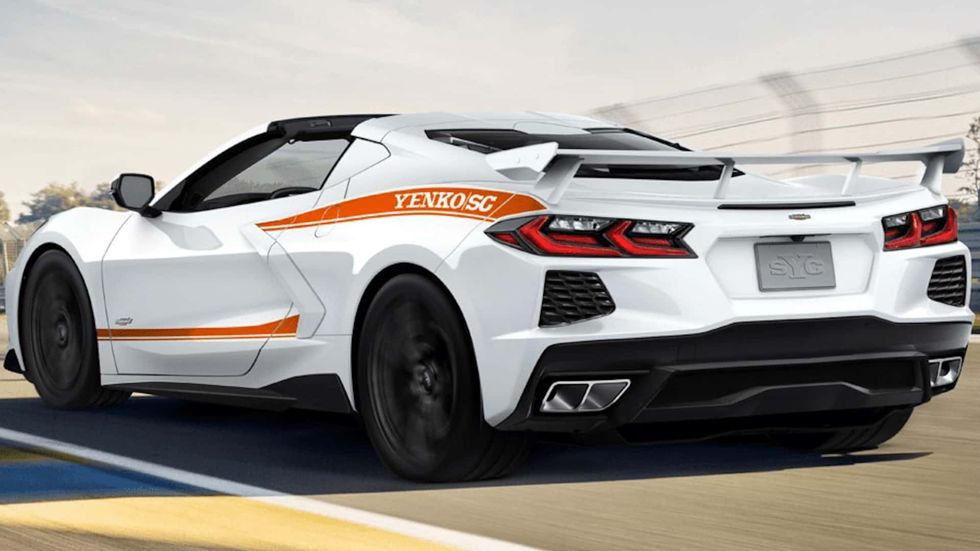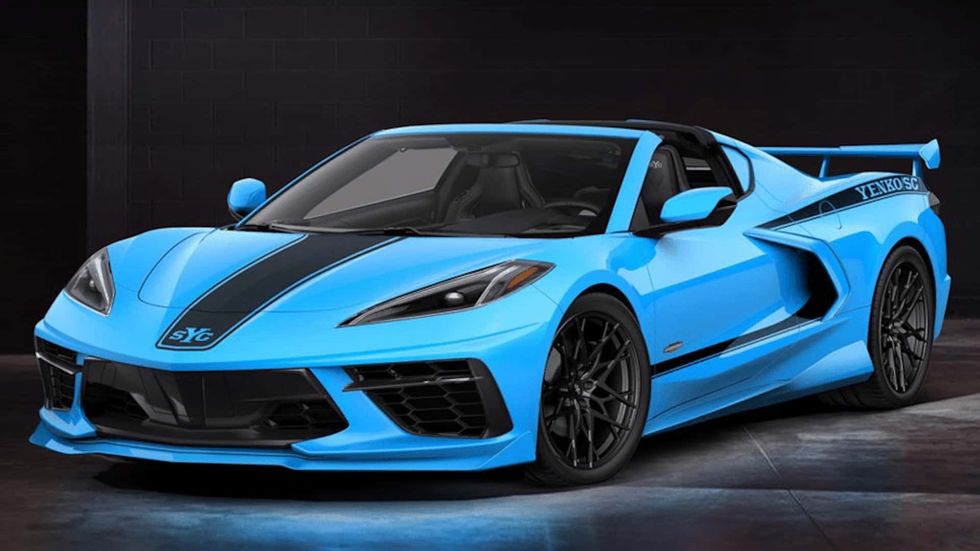
Buy
Resources
Entertainment
Magazine
Community
In This Article
Category:
Magazine
Five flashing spokes. Nighttime glinting wildly off brilliantly buffed metal. Looking tougher in a ride that's already tough. This is the world of the performance wheel, and we think we can argue convincingly that no single wheel design has defined the performance world more forcefully than the Cragar S/S. None. Even those who prefer other styles would probably never question that statement. Custom or performance wheels have erroneously been called "mags" for generations, but if that's a misused term, it has been given life by the creation of this great American aftermarket brand.
"Cragar" is something of an acronym, the name having been created by Crane Gartz, the heir to a Los Angeles publishing fortune, who tried to market the Miller-Goossen head for Model As during the Depression and eventually sold the patterns to Bell Auto Parts founder George Wight, who died in 1943. At that point, a young kid named Roy Richter, who had been a successful race driver and a Cragar fabricator (when it was owned by Gartz and former "boy wonder of the board tracks" Harlan Fengler), mortgaged everything he had to lease the tiny Bell auto shop, which was doing an increasingly strong business producing and selling the Cragar parts.
Through the end of the 1940s, and increasingly so for the next 15 years, the American high-performance industry boomed, but the performance or custom wheel remained largely unknown on the street. Hot rodders still relied heavily on old steel discs or Kelsey-Hayes wire wheels. Owners of newer cars simply removed the hubcaps to look tough. Real "mags" were actually made from magnesium, most famously Halibrands, and aimed at pure racing cars. Later came the so-called chrome reversed wheel. Spoked custom wheels, when they appeared, usually consisted of cast-aluminum centers riveted to chromed steel rims, not the best formula for integrity. The area where spokes met the wheel's center flange was usually especially weak, given that that area had to endure most of the kinetic force being applied to the unit.
Richter figured he could do better. Intending to use the Cragar name, he came up with a patented method of mating the wheel's aluminum spokes and center with the steel rim through pressure casting. As Richter told biographer Art Bagnall, "We determined that a stock wheel was permanently distorted at 26,000 pounds (of pressure)...by changing spoke depth and rim location, we were able to attain a minimum static load strength of 41,000 pounds."
Specifically, the manufacturing technique that Richter employed involved taking the chrome rim, which was selected for being impervious to high impacts and side-directed thrust forces, and making it the focus of the wheel's overall strength. In a break with then-common industry practice, no rivets or drive screws were used to attach the rim to the wheel's center section. Five steel locking clips, one for each of the wheel's spokes, were cast into the center section. Each of the steel locking clips was then welded to the wheel's steel rim.
The new wheel, a simple but handsome design incorporating tapered, polished spokes, was called the Super Sport or as expressed on its hub, the S/S. The very first production set went to Hot Rod publisher Ray Brock, who installed them on his new 1964½ Ford Mustang. They rapidly multiplied by the tens of thousands, and swiftly found their way to drag strips, road courses, and even to auto thrill show teams. Only a few months had elapsed since the S/S was introduced before demand forced Richter to relocate production to a new plant in nearby Bell Gardens, where about 20 workers soon found themselves doing nothing else but assembling S/S wheels for a voracious marketplace.
Within another six months, that 5,000-square-foot plant would be supplanted by one in South Gate with seven times the space. Richter's health began to crumble, however, and in 1971, he sold his interest in Cragar to Wynn's oil. Richter died in 1983 at age 69. Today, the S/S is still vibrant, sold in a huge range of offsets and diameters, and is produced by Cragar Industries Inc. of Phoenix.
Recent
Hemmings.com, the premier online marketplace for classic cars, collector vehicles, and automotive enthusiasts, proudly announces a significant milestone: the sale of 2,500 vehicles through its innovative Make Offer platform. Achieving this remarkable feat in just over a year since its inception underscores Hemmings’ commitment to revolutionizing the buying and selling experience for collector car enthusiasts.
"Reaching 2,500 cars sold through the Make Offer platform is a significant milestone for Hemmings," stated Jonathan Shaw, Hemmings' president. "It underscores our commitment to delivering secure, efficient solutions that enhance the collector car experience, which fosters trust within our community and further solidifies the impact of our frictionless marketplace.”
Interested in selling your car on Hemmings?
The Hemmings Make Offer product was introduced just over a year ago, empowering buyers and sellers with a flexible and streamlined negotiation process. This unique tool allows buyers to submit offers directly to sellers, facilitating transparent and efficient transactions. With its user-friendly platform, Make Offer has swiftly become a preferred method for sealing deals within the Hemmings community.
"We couldn't be happier with how the Hemmings Make Offer platform has helped Black Horse Garage and introduced us to new clients. The business partnership between Black Horse Garage and Hemmings has given us a new avenue to introduce and offer our special automobiles to the vast customer base that Hemmings has had for so many years,” said Don Laviano, Communications Manager of Black Horse Garage as he expressed his satisfaction with the partnership with Hemmings. “Their platform has been easy to use for us and the car buying public. It is engaging, enjoyable, and successful. Black Horse Garage looks forward to being a part of their next 2,500 sales!”
The success of the Hemmings Make Offer feature is part of Hemmings' commitment to innovation and customer satisfaction. By leveraging cutting-edge technology and industry expertise, the feature continues to set new standards for excellence in the automotive marketplace.
Make Offer is built to take the hassle out of collector car buying and selling and is supported by the Hemmings.com suite of services, including Pay + Title, collector car valuation, shipping and an insurance marketplace.
Hemmings.com Marketplace
Hemmings.com is the world’s largest collector car marketplace and includes a mobile app. Whether you're a novice or a seasoned collector, our seamless, integrated services offer an accessible entry point for all.
- Pay + Title: Powered by KeySavvy, the service offers the safest, easiest, and fastest way to transfer funds and titles between buyers and sellers. Pay + Title simplifies the process, which can often be complicated, particularly across state lines.
- Hemmings Valuations: Hemmings has been providing the resources to “check the pulse” of the collector car market since its founding in 1954. Hemmings’ personalized vehicle valuation service provides a detailed report prepared especially for an individual’s collector car.
- Hemmings Shipping: Hemmings has teamed up with Acertus to deliver a seamless collector car shipping solution directly to its customers.
- Hemmings Insurance Marketplace: Hemmings has teamed up with InsuraMatch, empowering owners and prospective buyers to receive free quotes and procure insurance policies from multiple carriers specializing in classic, collector, and exotic vehicle coverage.
As Hemmings looks ahead to the future, its mission remains steadfast in connecting buyers and sellers, preserving automotive history, and fueling collectors' passions. With Make Offer as a strong element of the frictionless marketplace, the journey promises to be even more exhilarating and rewarding for all who share a love for classic cars and collector vehicles.
About Hemmings:
Founded in 1954, Hemmings is the world’s largest collector car marketplace. For nearly 70 years, our purpose has been to grow and uplift the collector car community because we’ve been part of it since the start of it. We help all willing drivers buy, sell, and beyond through a frictionless marketplace, quality entertainment and professional service. More information, services and content are available at Hemmings.com. Stay connected with Hemmings on Facebook, Instagram, and YouTube. Search tens of thousands of vehicle listings from the palm of your hand with the new Hemmings App.
Keep reading...Show Less
Specialty Vehicle Engineering
Specialty Vehicle Engineering (SVE) has done it again with its latest power-adding limited-edition build, this time for the 2024 Chevrolet Corvette. The latest Yenko/SC sports car received some serious upgrades for the sizeable boost in performance that Yenko-badged vehicles are known for.
The Yenko 2024 Chevrolet Corvette is powered by a twin-turbocharged 6.2-liter LT2 V8 engine capable of 1,000 horsepower, around double the power of a stock Corvette. Depending on the 2024 Corvette’s trim level, the factory power ratings run between 490 to 670 horsepower.
Releasing 1,000 horses out of the stable was made possible by the addition of two 58-millimeter water-cooled turbochargers, but before the turbos were tacked on, the V8 engine received some upgrades of its own. An ARP high-strength head, a forged steel crankshaft, forged H-beam rods, forged aluminum pistons, and a proprietary camshaft strengthen the internals, while a custom intake manifold, CNC ported high-flow cylinder heads, an upgraded fuel system, and a custom tune further opens up the L2 to all the added power. SVE couldn’t stop there: The Corvette’s eight-speed dual-clutch gearbox was also upgraded to withstand the extra power and blast it to the rear wheels.
SVE tops off the upgraded powertrain with custom valve covers. In the rear, distinctive exhaust tips are added and are available in silver or black. Yenko-badged brake calipers can be had in select colors, with the standard option being red. Three different designs of staggered 19-inch front and 20-inch rear wheels are also available in various finishes. Inside of the new Yenko Corvette are embroidered logos on the headrests and floormats, characteristic of the company’s other Yenko offerings.
SVE is offering its Yenko Corvette in coupe or convertible body styles, with any of the currently available factory Corvette color choices. Nine colors are available for the SYC graphics, plus the addition of a tenth carbon fiber option.
SVE confirms it will build just 10 Yenko/SC Corvettes for the 2024 model year, but that production number will increase to 50 for 2025. The Yenko/SC Corvette package starts at $99,995, not including the initial cost of purchasing a new Corvette.
Are Yenko muscle cars more your style? Check out the latest supercharged 2024 Yenko/SC Chevrolet Camaro that makes more power than a supercar.
Keep reading...Show Less










